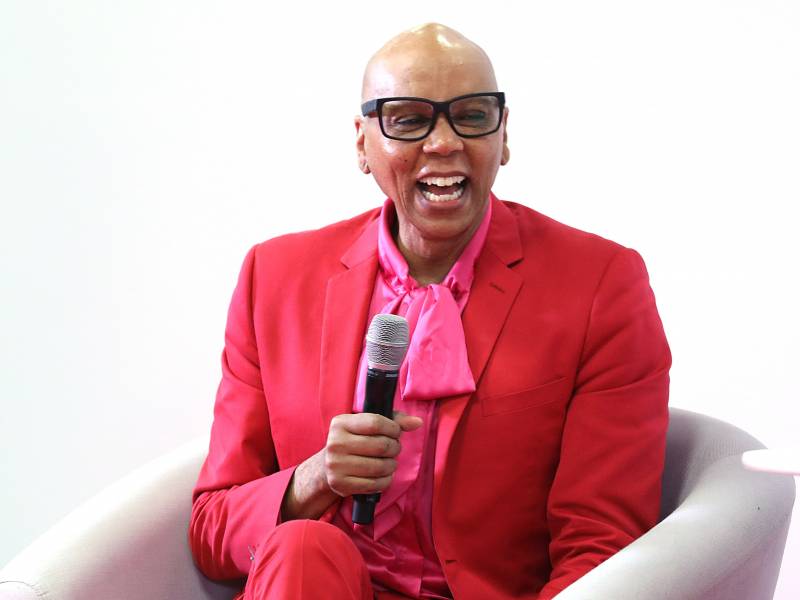RuPaul, who splits time between Los Angeles and a 60,000-acre ranch in Wyoming, says one of the secrets to his success is adaptability.
“In this life, if you can stay flexible, you have a really good chance of navigating a really rich experience for yourself on this planet,” he says.
Interview highlights
On his belief that identity is an illusion
It’s all a lie—this world is a lie. So don’t base your value on the lie. I’ve always been attracted to things that were irreverent, [like] Monty Python, I thought, “Oh, there’s my tribe!” Because even as a kid, I knew that I had a sense that none of this was real, that it was all an illusion and that it would be a mistake to base my value on the lie: Boys, go here. Girls go there. Blacks over here, whites over here … all these superficial rules we come up with are just BS!
On how his mother influenced his punk sensibility
My mother was very world-weary. She was someone who I suspect—and she wasn’t very open about anything in her childhood or her background—but I suspect that some horrible thing had happened to her. I felt that. She never talked about it, but she was someone who, because of her world weariness, she instilled in me the ability to not pay attention to what other people had to say about what I was doing. She loved me so much, and she was so proud of the fact that I was gonna do my own thing.
So it was a very punk rock approach to life, and I got that from her. She famously says, “If they ain’t paying your bills, pay them no mind.” And I lived my life that way. Yes, I mean, people have said lots of nasty things about me to me and still do, but am I gonna let that stop me? Uh-uh. I will laugh at it and say … The joke is on you, person, because I am going to get as much out of this life as I possibly can—and I have! At 59 years old, I have done a lot of stuff and I’m still going to do a lot of stuff.
On the nightclub scene in the Village in New York in the late ’80s
We were the children of Warhol. We were the children of David Bowie. And all things were possible. There was a club scene. And back then there were so many clubs. You could go to six different nightclubs per night. And we’re talking Monday through Sunday. You could go every night to a different nightclub. And back then, the clubs were filled with everyone—straight, gay, black, white, Puerto Rican, uptown, downtown, men, women, everybody. And that was the scene, that tapestry of what New York is, or was, was so evident in the nightclub scene. And it was fabulous! It was gorgeous. I’m so proud and so happy I got to experience that.
On establishing the “Glamizon” look of drag he’s now known for today
[In 1989] I worked on a demo tape so I could send it to a record company. And that’s what I did for a year. I worked on a demo and basically ate popcorn and seltzer water from the Film Forum because I had a friend who worked there, and so that’s how I sustained myself. And I do a … few gigs here and there. But I wasn’t in the clubs every night like I had been. And in ’92, I got a record deal with Tommy Boy Records, which was a subsidiary of Warner Bros. Records. I had also met with Mathu and Zaldy, two visual designers [on] costume, makeup, everything, and we’d come up with my look, which was then elevated from my Soul Train dancer look … to the glamazon that you know today. It’s very studied and precise … and that’s how it came about.
But also, I knew that, commercially, as someone who’s paying attention, that if I wanted to make it mainstream, I would have to be non-threatening to Betty and Joe Beer Can. And what I did was I came up with a recipe, which was one-part Cher, two-parts David Bowie, one-part Diana Ross and two heaping spoonfuls of Dolly Parton.
On why drag queens model themselves after the icons like Cher, Liza Minnelli, Barbra Streisand and Diana Ross
I’ll tell you exactly what it is: It is that they embody both strength and vulnerability. And that is what the child in you, in me and everyone listening remembers, deep in the recesses of your consciousness. … The ability to oscillate between those two emotions, that the strength and the vulnerability is what we are doing on this planet. And that balance, dear listener, is what life is all about. It’s not one or the other. And all of these women that you talked about—Cher and Diana, Barbra—they all exemplify … that vulnerability and strength, that duality.

9(MDAxOTAwOTE4MDEyMTkxMDAzNjczZDljZA004))

